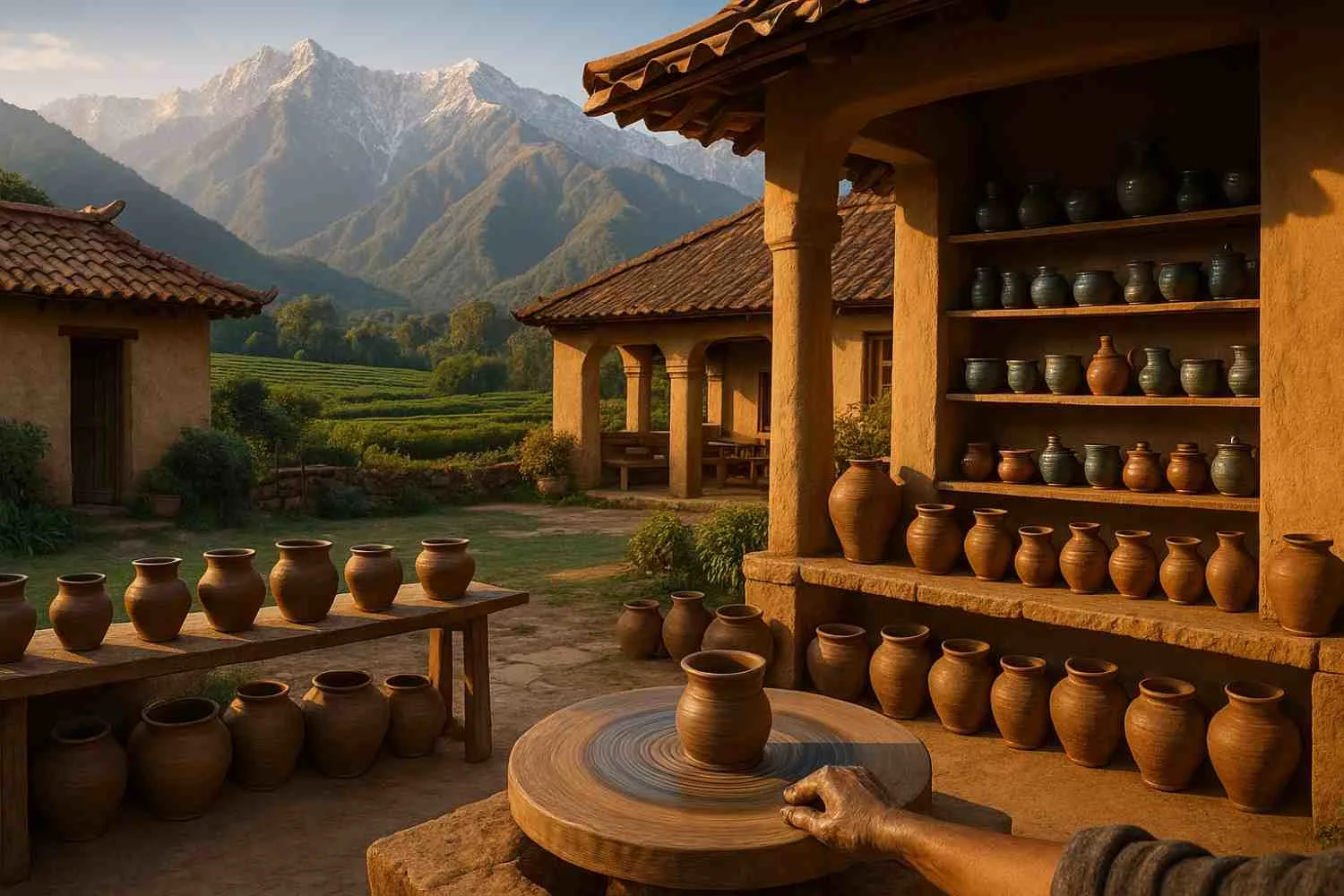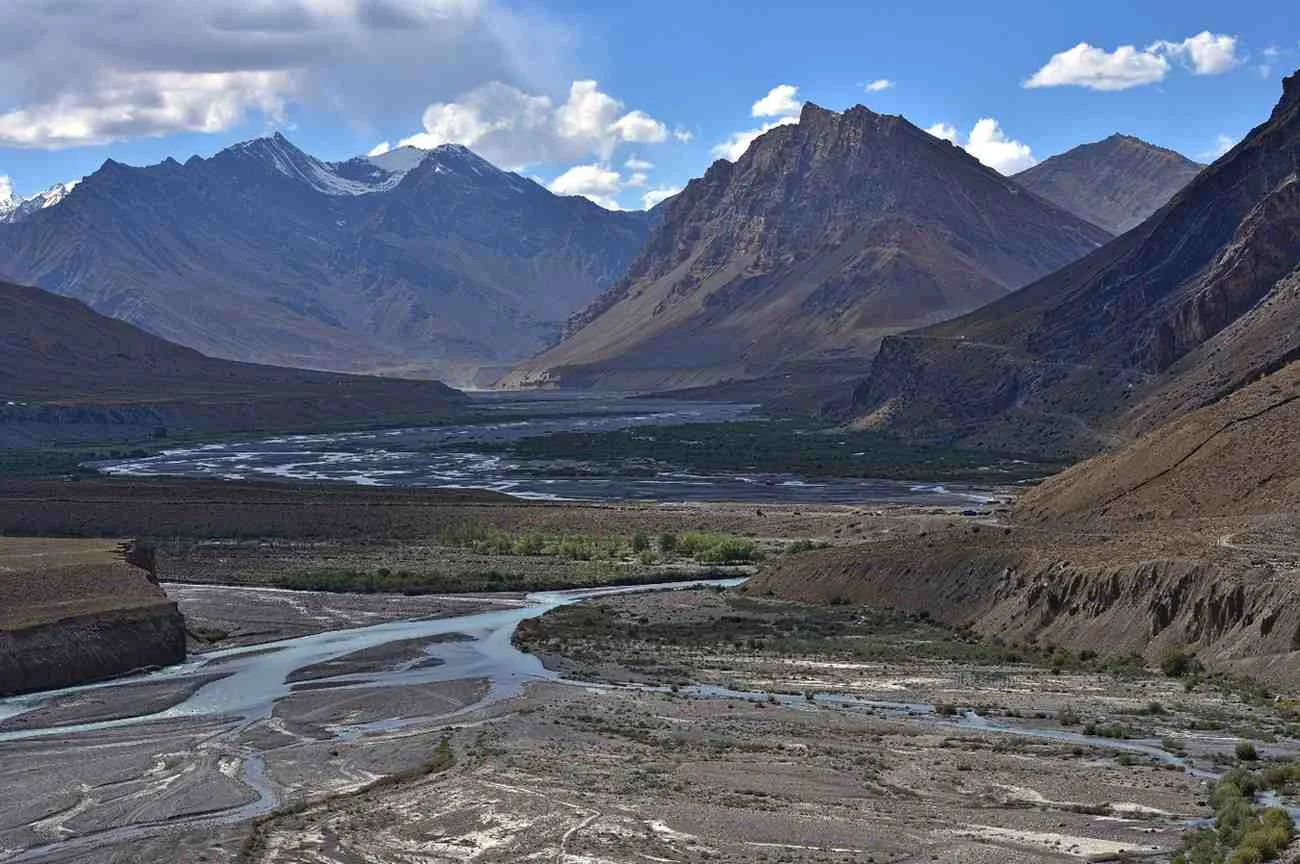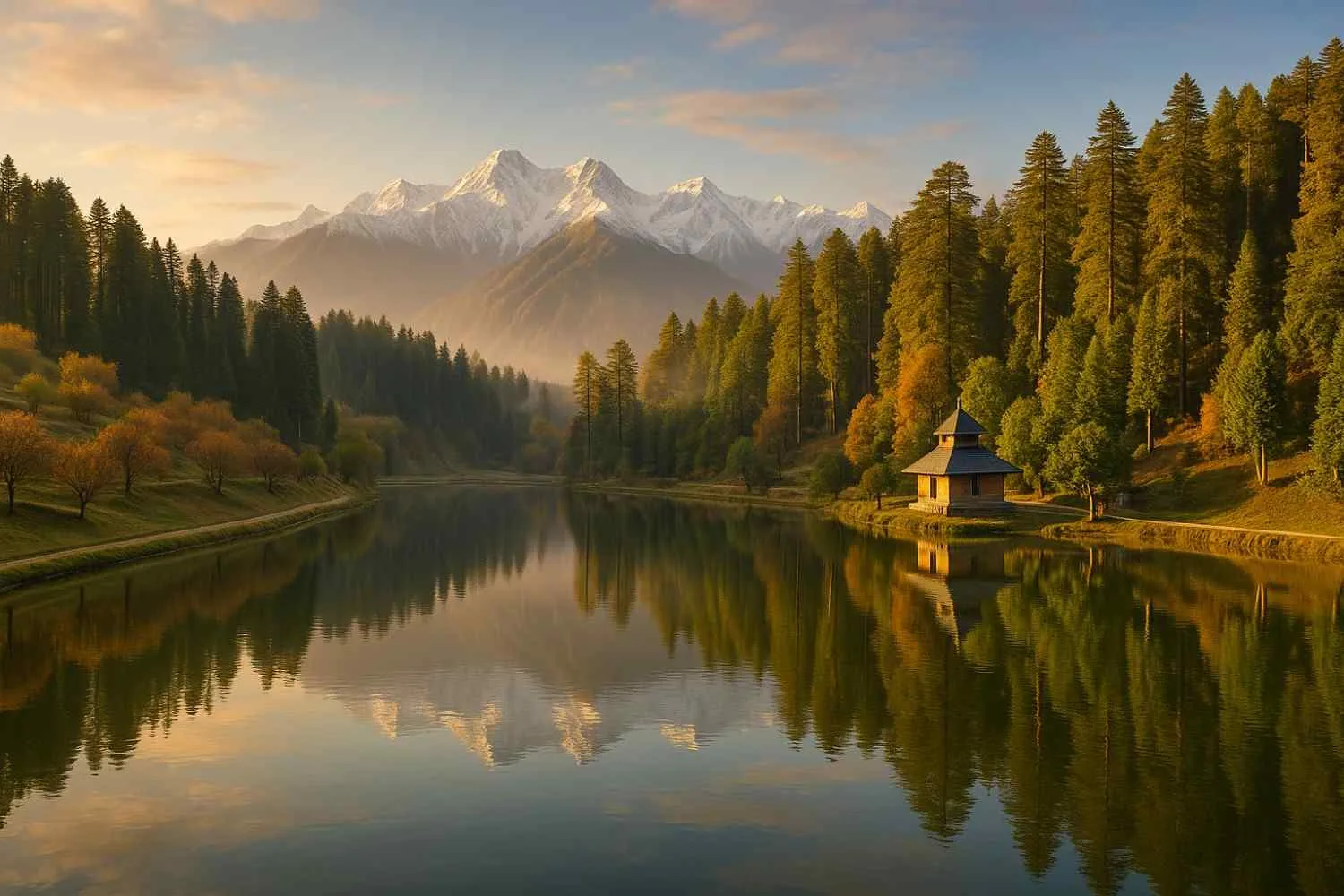Tashi Jong Monastery is a tranquil Buddhist monastery nestled in Tashi Jong village near Palampur in the Kangra Valley of Himachal Pradesh, India. It is home to the Drukpa Kagyu tradition and a thriving monastic community, known for its vibrant Tibetan architecture, serene prayer halls, fluttering prayer flags, and the gentle rhythm of monastic life. If you’re seeking a calm cultural stop amid the Dhauladhar mountains, this Tibetan monastery—also known locally as Khampagar Monastery—is one of the region’s most peaceful spiritual destinations.
Quick Facts About Tashi Jong Monastery
| Feature | Detail |
| Location | Tashi Jong Village, near Palampur, Kangra District, Himachal Pradesh |
| Founded By | Eighth Khamtrul Rinpoche |
| Established In | Late 20th century |
| Religion Type | Drukpa Kagyu Buddhist Monastery |
| Entry Fee | Free |
| Visiting Hours | 8 AM – 6 PM |
| Ideal Visit Duration | 1–2 hours |
| Nearest Town | Palampur (≈ 15 km) |
Tashi Jong Monastery History and Significance
1. Origins and the Khamtrul Rinpoche lineage
Tashi Jong’s story is inseparable from the revered Khamtrul Rinpoche lineage of the Drukpa Kagyu school. The Eighth Khamtrul Rinpoche played a pivotal role in guiding disciples and reviving the lineage’s institutional base in exile, ultimately taking root in the Kangra Valley. The monastery’s presence in Himachal Pradesh has allowed the lineage to continue its teachings, practices, and artistic traditions with dignity and continuity.
2. Migration and the monastic settlement
After 1959, waves of Tibetan refugees sought sanctuary in India. Monks, nuns, artisans, and lay followers of the Drukpa Kagyu tradition gathered in the Kangra region, gradually shaping Tashi Jong as a self-sustaining monastic settlement. Over the years, cells, prayer halls, craft workshops, and communal spaces blossomed around a shared mission: preserving spiritual life while rebuilding community in a new land.
3. A cultural and educational center
Beyond daily prayers and rituals, the monastery functions as a center of Tibetan culture and education—from classical Buddhist studies and philosophy to thangka painting, woodwork, and ritual arts. For visitors, Tashi Jong offers a living classroom where faith, heritage, and Himalayan landscapes quietly converge.
Tashi Jong Monastery Architecture and Design
1. Traditional Tibetan aesthetic
At first glance, you’re greeted by a classic Tibetan monastery profile: bright ochres and reds, gilded dharma wheels, and tiered roofs trimmed with ornate carvings. Colorful prayer flags stretch between courtyards, lending movement and color to the mountain breeze; nearby chortens (stupas) and mani walls add symbolic punctuation to the grounds.
2. Main prayer hall and sacred art
The heart of any monastery is its dukhang (main prayer hall). Inside, you’ll find murals depicting protectors, masters, and episodes from the Buddha’s life, along with statues that embody compassion and wisdom. Butter lamps flicker softly, the scent of incense lingers, and the rhythmic intonation of mantras can sometimes be heard during prayer times.
3. Backdrop of the Dhauladhar
Set against the snow-flecked Dhauladhar range, Tashi Jong’s architecture feels harmoniously anchored to the hills. Terraced fields, pine groves, and open skies frame the complex, making the monastery not only spiritually calming but also aesthetically captivating.
Tashi Jong Monastery Spiritual and Cultural Activities
1. Daily rhythm
Monks follow a disciplined schedule of morning and evening prayers, study sessions, and meditation. Visitors may occasionally witness group chanting and low, resonant gyaling and drum accompaniments—gentle yet stirring.
2. Festivals and ceremonial dances
Tashi Jong observes important Tibetan Buddhist festivals such as Losar (Tibetan New Year)—typically falling in late winter or early spring—and special Cham (masked) dances on select auspicious days. The Cham is both sacred ritual and performative teaching: costumed monks enact timeless themes of moral clarity, compassion, and the triumph of wisdom.
3. Preserving the Drukpa Kagyu lineage
The monastery safeguards the Drukpa Kagyu teachings through training, liturgy, ritual craft, and the careful transmission of knowledge from senior lamas to younger monks. For seekers, this offers a rare window into a living Himalayan tradition.
How to Reach Tashi Jong Monastery
- By Air: Kangra (Gaggal) Airport – approx. 40 km
- By Train: Pathankot – approx. 120 km (then road onward via Nurpur/Jaisinghpur/Palampur axis)
- By Road: Access via NH-503 from Palampur or Baijnath; local roads lead directly to Tashi Jong village
Pro tip: If you’re already in Palampur, a taxi or local bus can get you to Tashi Jong in under an hour, depending on stops and road conditions.
Best Time to Visit Tashi Jong Monastery
| Season | Experience |
| March – June | Pleasant weather and clear views |
| July – Aug | Lush landscapes; occasional monsoon showers |
| Sep – Nov | Crisp skies, excellent for photography and festivals |
| Dec – Feb | Cold, peaceful winter ambience and fewer crowds |
Things to Do at Tashi Jong
- Attend a monk prayer session (as a quiet observer).
- Explore the Khampagar Monastery complex and its courtyards.
- Browse craft workshops/shops for Tibetan souvenirs—think thangka prints, prayer flags, incense.
- Savor the views—the gardens and vantage points around the complex frame the Dhauladhar beautifully.
Tashi Jong Monastery Nearby Attractions
- Andretta Artist Village – Andretta Artist Village~10 km (pottery, galleries, and a creative rural vibe)
- Baijnath Temple – Baijnath Temple ~20 km (ancient Shiva temple, exquisite stone work)
- Palampur Tea Gardens – Palampur Tea Gardens ~12 km (walks amid emerald plantations)
- Bir Billing – Bir Billing ~35 km (India’s paragliding hotspot with cafés and views)
Tashi Jong Monastery Travel Tips
- Maintain silence in prayer areas; switch phones to silent.
- Avoid entering during midday prayer if doors are closed; wait for visiting hours.
- Dress modestly; remove shoes before entering the prayer hall.
- Carry cash—ATMs are limited in smaller villages.
Why Visit Tashi Jong Monastery
- A soothing blend of spiritual serenity and Himalayan scenery.
- An intimate, authentic insight into Tibetan culture and monastic life.
- A perfect cultural stop on itineraries around Palampur and the Kangra Valley—balanced, unhurried, and photogenic.
Conclusion
Tashi Jong Monastery is one of Himachal Pradesh’s gentlest treasures: a place where ritual, art, and everyday devotion quietly animate the hills. Whether you’re a spiritual seeker or a culture-curious traveler, you’ll find the pace here slowing naturally—the way prayer flags find their own rhythm in the wind.
FAQ – Tashi Jong Monastery
Where is Tashi Jong Monastery located?
In Tashi Jong village, near Palampur, Kangra District, Himachal Pradesh, India.
How far is Tashi Jong Monastery from Palampur and Dharamshala?
About 15 km from Palampur; roughly 60–65 km from Dharamshala (road-dependent).
What is the altitude of Tashi Jong Monastery?
Approximately 1,250–1,350 m above sea level (similar to Palampur’s elevation).
How can I reach Tashi Jong Monastery by road or train?
Road: Via NH-503 through Palampur/Baijnath; local turn-off to Tashi Jong.Train: Nearest major railhead is Pathankot (~120 km), then road transfer.
Is Tashi Jong Monastery open to visitors throughout the year?
Yes, year-round, subject to weather and monastery schedules.
What is the best way to reach Tashi Jong from Palampur?
Taxi is quickest; local buses also ply but are slower with more stops.
Does Tashi Jong Monastery charge any entry fee?
No, entry is generally free.
What are the visiting hours of Tashi Jong Monastery?
Typically 8 AM – 6 PM (confirm on arrival; prayer times may limit access to certain halls).
When was Tashi Jong Monastery established?
In the late 20th century.
Who founded Tashi Jong Monastery?
The Eighth Khamtrul Rinpoche is credited with its founding and guidance.
What is the historical significance of Tashi Jong Monastery?
It’s a key exile-era seat preserving Drukpa Kagyu teachings, arts, and community life.
Which Buddhist lineage or sect does Tashi Jong Monastery belong to?
Drukpa Kagyu (Kagyu tradition of Tibetan Buddhism).
What does the name “Tashi Jong” mean?
In Tibetan, “Tashi” implies auspicious, and “Jong” means fort/valley/seat—often read as “Auspicious Valley/Seat.”
What role does Tashi Jong play in Tibetan Buddhism?
It serves as a teaching, practice, and cultural center for the Drukpa Kagyu lineage.
Is Tashi Jong Monastery associated with Khamtrul Rinpoche?
Yes, it is a principal seat of the Khamtrul Rinpoche lineage
What is the architectural style of Tashi Jong Monastery?
Traditional Tibetan monastery style—tiered roofs, vivid colors, dharma symbols.
What makes the design of Tashi Jong Monastery unique?
Its harmonious setting with the Dhauladhar, intricate murals, and stupas accenting landscaped courtyards.
What can visitors see inside the monastery complex?
Prayer halls, murals, statues, chortens, prayer wheels, and quiet gardens.
Are there monks living at Tashi Jong Monastery?
Yes, it’s an active monastic community.
Does Tashi Jong have a prayer hall or meditation area open to tourists?
The main prayer hall is generally accessible to respectful visitors during open hours.
Are photography and videography allowed inside the monastery?
Outside—usually fine. Inside halls—ask permission; no flash and no disturbance.
What are the main festivals celebrated at Tashi Jong Monastery?
Losar (Tibetan New Year) and select Cham (masked dance) days, among other auspicious dates.
What cultural or religious events are held annually?
Ritual prayer ceremonies, teachings, and masked dances tied to the Tibetan lunar calendar.
What are the top things to do at Tashi Jong Monastery?
Observe prayers, explore the Khampagar complex, shop for crafts, and enjoy mountain vistas
How much time is needed to explore Tashi Jong Monastery?
1–2 hours comfortably; longer if you linger for prayers or photography.
Are guided tours available for visitors?
Formal tours are limited; ask on site—sometimes a monk or staff member may offer brief guidance.
Is there any dress code for entering the monastery?
Modest clothing covering shoulders and knees is recommended.
Are there restaurants or cafes near Tashi Jong Monastery?
Small local eateries/tea stalls may be nearby; broader options in Palampur.
What are the accommodation options near Tashi Jong?
Guesthouses and hotels in Palampur and Baijnath suit various budgets.
Is the monastery suitable for family visits?
Yes—peaceful and educational for families with respectful children.
Are toilets and basic facilities available for tourists?
Basic facilities are typically available; carry essentials and cash.
Which places can I visit near Tashi Jong Monastery?
Andretta, Baijnath Temple, Palampur Tea Gardens, Bir Billing.
How far is Tashi Jong from Andretta Artist Village?
Around 10 km.
Can I visit Baijnath Temple and Tashi Jong on the same day?
Yes—20 km apart, commonly combined.
Are there trekking routes or scenic spots near Tashi Jong?
The Kangra Valley offers gentle village walks, tea-garden strolls, and ridge viewpoints.
Is Tashi Jong close to Palampur Tea Gardens?
Yes—about 12 km.
How far is Bir Billing from Tashi Jong Monastery?
Roughly 35 km by road.
What is the best time to visit Tashi Jong Monastery?
March–June and Sep–Nov for clear views and festivals.
How is the weather in Tashi Jong throughout the year?
Pleasant spring, monsoon rains in July–Aug, clear autumn, chilly winters.
Is winter a good season to visit Tashi Jong?
Yes, if you enjoy quiet and crisp air; carry warm clothing.
When are the major festivals or prayer ceremonies held?
Around Losar and specific lunar dates; check locally for exact schedules.
What meditation or spiritual programs are offered at Tashi Jong?
Primarily monastic programs; short public teachings may occur—ask on arrival.
Can tourists participate in Buddhist prayers or rituals?
You may observe quietly; participation is limited and subject to monastery guidance.
Is there a monastery guesthouse for visitors?
Accommodation is generally external; inquire locally if any limited stays are allowed during events.
Are there any souvenir or handicraft shops inside Tashi Jong?
Yes—small craft shops often sell incense, prayer flags, art prints, and handmade items.
What rules should visitors follow at the monastery?
Silence, modest dress, no shoes in halls, no disruptive photos, and respect prayer times.
What is the daily routine of monks at Tashi Jong Monastery?
Morning/evening prayers, study, ritual practice, community chores, and personal meditation.
Is Tashi Jong Monastery eco-friendly or sustainable?
Practices tend to be low-impact, with traditional materials and careful resource use typical of monastic life.
Why is Tashi Jong Monastery famous among tourists and pilgrims?
For its serenity, authentic Tibetan culture, and Dhauladhar backdrop—a rare, unhurried atmosphere.
What is the distance between Tashi Jong and Kangra Airport?
Approximately 40 km.
How safe is Tashi Jong Monastery for solo travelers?
Generally safe; standard rural travel precautions apply.
What is the nearest bus stop or railway station to Tashi Jong?
Local buses connect via nearby villages/Palampur; major rail is Pathankot.
Can foreigners visit and stay near Tashi Jong Monastery?
Yes—foreigners can visit; stays are best arranged in Palampur/Baijnath.
What makes Tashi Jong Monastery a must-visit place in Himachal Pradesh?
Its living spiritual heritage, Tibetan artistry, and mountain calm—all within easy reach of Palampur.






